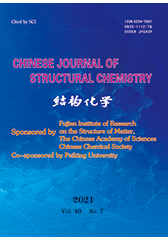Molecular Structures and Catalytical Performance in Suzuki-coupling
Reaction of Novel Dipalladium Clip-shaped
Complexes with Bifunctional Pyrazolate Ligands
HU Xiao-Peng, WANG Zhi-Feng, DENG Wei, TONG Jin and YU Shu-Yan*
Chin. J. Struct. Chem. 2021, 40, 843-850 DOI: 10.14102/j.cnki.0254-5861.2011-3174
July 15, 2021
dipalladium supra molecules, bifunctional pyrazolate ligands, catalysis, Suzuki-coupling reaction
ABSTRACT
A series of clip-shaped
cationic molecular corners C1~C4 (C1
= [(bpy)2Pd2(L1)2]2+, C2 = [(dmbpy)2Pd2(L1)2]2+, C3 = (bpy)2Pd2(L2)2]2+, C4 = (dmbpy)2Pd2(L2)2]2+, bpy = 2,2-bipyridine, dmbpy
= 4,4΄-dimethyl-2,2-bipyridine)
were synthesized through dipalladium complexes [(bpy)2Pd2(NO3)2](NO3)2,
[(dmbpy)2Pd2(NO3)2](NO3)2 and bifunctional pyrazole ligands 4-(3,4-dimethoxyphenyl)-3,5-dimethyl-1H-pyrazol
(HL1) and 4,4΄-(5-(1H-pyrazol-4-yl)-1,3-phenylene)dipyridine
(HL2). Complexes C1~C4 were characterized by 1H and 13C NMR, electrospray ionization mass spectrometry
(ESI-MS), elemental analysis, and IR spectroscopy. The X-ray diffraction
analysis of C1∙2NO3− revealed a Pd2 dimetallic clip-shaped structure which was
synthesized by two bifunctional ligands doubly bridged by the [(bpy)Pd]2 dimetal units. Additionally, all of the complexes with NO3− as counter anions exhibited high-efficiency
catalytical performance in
the Suzuki-coupling
reaction attributed to the tunable
impact and weak dinuclear Pd(II)···Pd(II) intramolecular bonding interaction.








